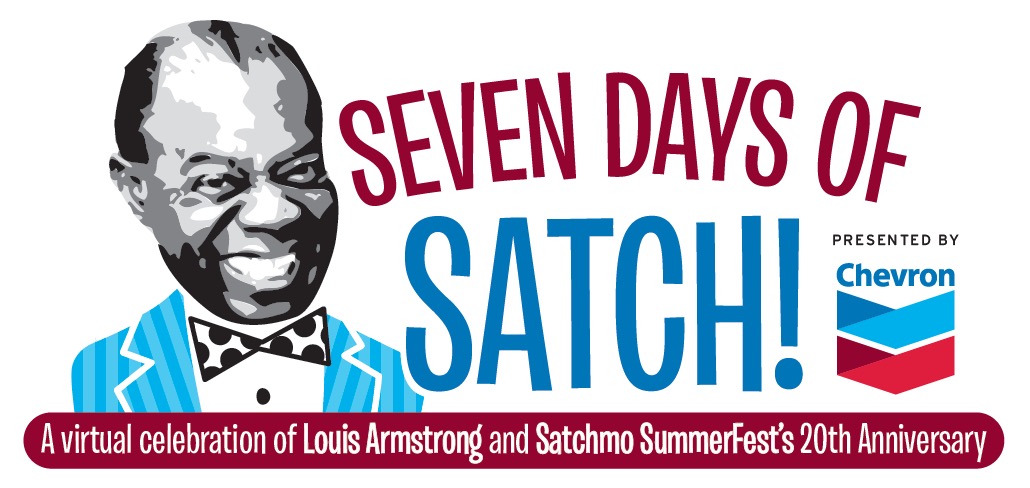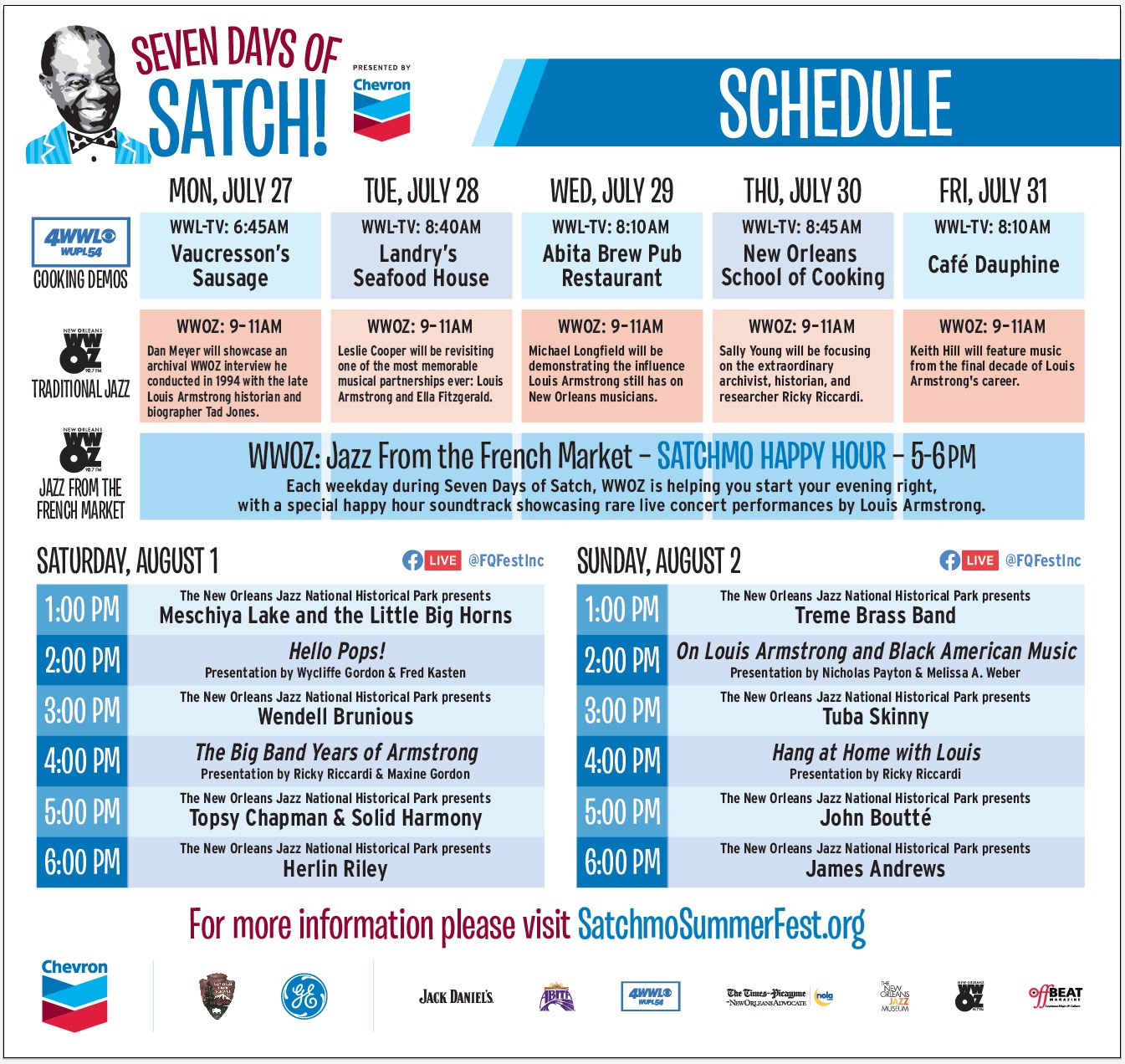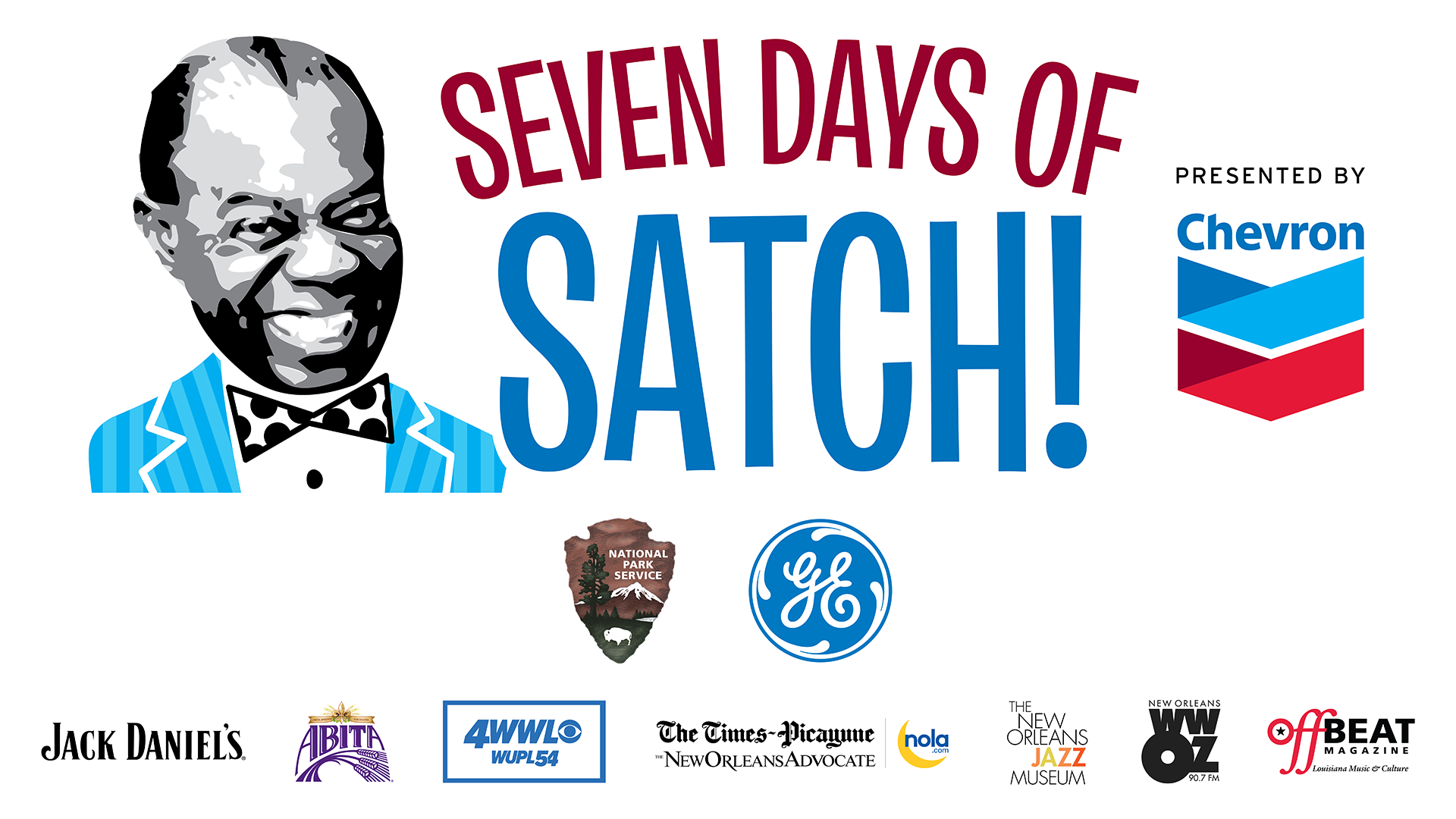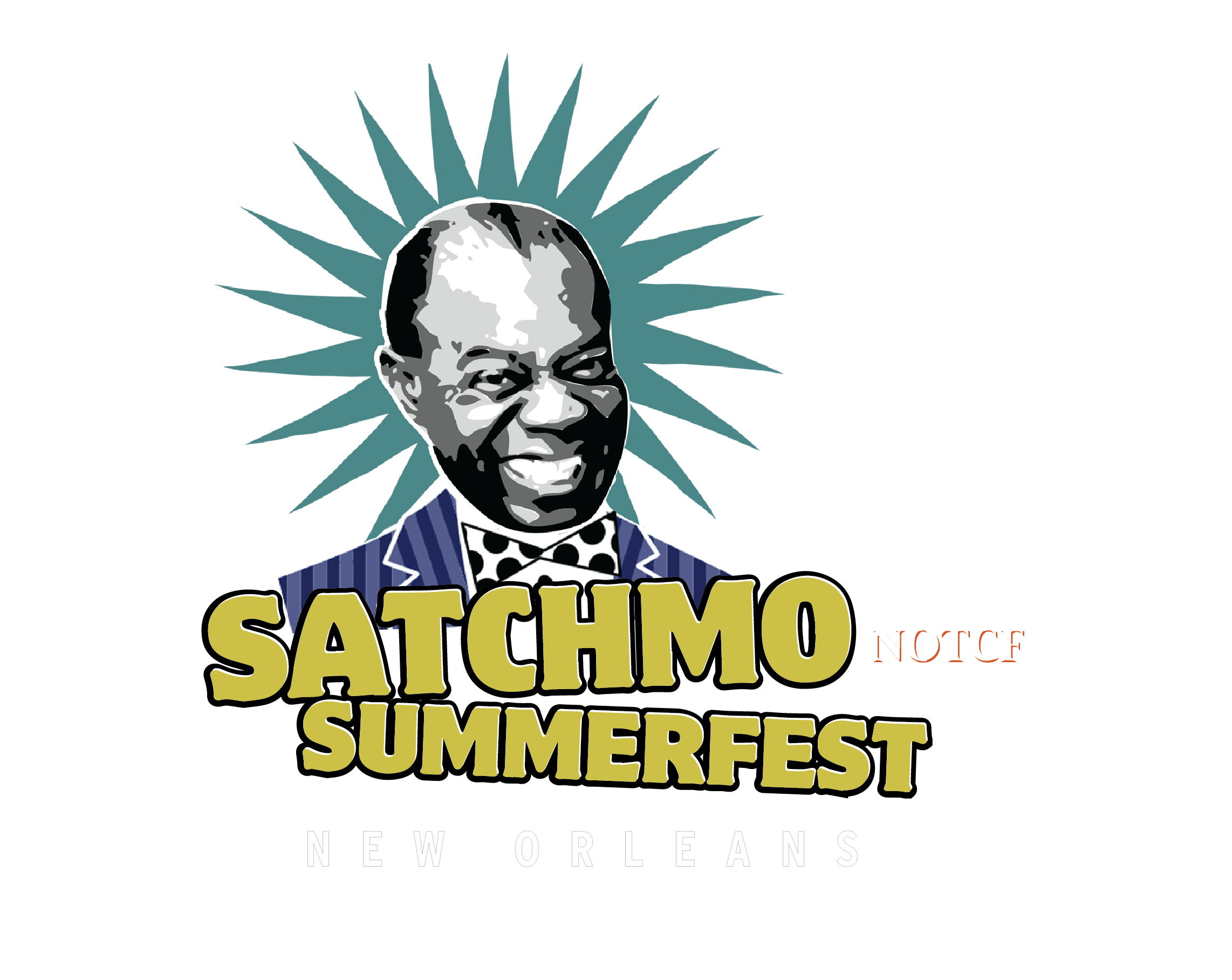
The Seven Days of Satch takes place July 27-Aug 2!
Sunday Jazz Mass at St. Augustine Catholic Church
Complete Schedule – Scroll Down to Watch!

Sunday, August 4, 2024
The presentation opens with the origin of the song "(What Did I Do to Be So) Black and Blue" and Louis Armstrong's reworked version, recorded in 1929, transforming it into the first major racial protest song in American popular music. He consciously included it in performances during his career to emphasize his ground-breaking musical statement on race in America. Armstrong's recording of "Black and Blue" took on a new life in 1952 when writer Ralph Ellison included it in the Prologue to his award-winning novel Invisible Man. It's integral to Ellison's thematic exploration of a Black man and his ability to fulfill the possibility of the American Dream. Ultimately, through their critical and cultural assessment of Armstrong and his music, Ellison and his colleague Albert Murray played a central role in elevating him to the stature he has achieved today and a testimony to the possibility inherent in Armstrong's life and music.
Using their encounter in Paris in 1934 as a starting point, the presentation seeks to explore parallels between the lives of Louis Armstrong and Panama Al Brown, the first Latin American World Boxing Champion, from their upbringing in New Orleans and Colon (Panama) to their triumph in Paris as icons of modernism and muses of the Surrealism Movement during the Jazz Age. The presentation also explores their mutual friendship with Luis Russell.
Roger Lewis is a founding Dirty Dozen Brass Band member and has played with numerous other artists, including Fats Domino, Eddie Bo, and the Treme Brass Band. He sits down with David Kunian, Curator of the New Orleans Jazz Museum, to talk about his storied life in music.
Luis Russell's passion during the last eight years of his life was filming and editing 8mm home movies. Visits to Louis Armstrong's House in 1961, New York City area scenes (a Caribbean parade in Harlem, visits to Coney Island, classic venues along Lenox Avenue, the funeral of Shelton "Scad" Hemphill attended by luminaries of Louis Armstrong's Orchestras) form a fascinating picture of a musician's life in New York City from 1956 through 1963.
The most talked-about Armstrong release of 2024 is Verve's Louis in London, a dazzling set of live recordings made at the BBC in 1968, capturing the "last hurrah" of Armstrong's storied career. GRAMMY-award winner Ricky Riccardi, who served as the set's co-producer and wrote the liner notes, will tell the tale of this release, sharing audio and video clips from the BBC concerts.
-
Al "Lil Fats" JacksonPresented by Danny & Alana Wolfe12:00 pm - 1:10 pm
-
Doreen's JazzPresented by Friend of Fest1:30 pm - 2:40 pm
-
Detroit Brooks with Special Guest Charmaine NevillePresented by The Laurel Bed and Breakfast3:00 pm - 4:10 pm
-
Shannon Powell's Traditional All-Star BandShannon Powell's Traditional All-Star Band | Presented by Sal Borelli4:40 pm - 5:50 pm
-
Brass-A-Holics with Flagboy GizBrass-A-Holics with Flagboy Giz6:20 pm - 7:50 pm
-
John Boutté12:20 pm - 1:30 pm
-
Steve Lands and Kosmi(k)rewePresented by New Orleans Jazz & Heritage Foundation1:50 pm - 3:00 pm
-
Wendell Brunious3:30 pm - 4:40 pm
-
The Original Pinettes Brass BandThe Original Pinettes Brass Band5:00 pm - 6:20 pm
-
Kermit Ruffins tribute to Louis ArmstrongPresented by New Orleans Jazz & Heritage Foundation6:40 pm - 8:00 pm
-
The Roots of Musicsponsored by Fidelity Bank11:15 am - 12:00 pm
-
"Black and Blue": Louis Armstrong and the American Dreamby Robert Cataloti | This discussion explores the origin of "(What Did I Do to Be So) Black and Blue" and Armstrong's reworked version, making it the first major racial protest song in American popular music.12:00 pm - 12:45 pm
-
Louis Armstrong and Panama Al Brown: Muses of the Avant-Garde Movement in 1930's Parisby Ariel Perez Price | Using their encounter in Paris in 1934 as a starting point, the presentation seeks to explore parallels between the lives of Louis Armstrong and Panama Al Brown, the first Latin American World Boxing Champion.1:00 pm - 1:45 pm
-
Roger Lewis, interviewed by David KunianRoger Lewis, founding Dirty Dozen Brass Band member, sits down with David Kunian, Curator of the New Orleans Jazz Museum, to talk about his storied life in music.2:00 pm - 2:45 pm
-
Home Movies: Louis Armstrong's New York City 1956 - 1963by Catherine Russell & Paul Kahn | This discussion forms a fascinating picture of a musician's life in New York City from 1956 through 1963 through 8mm film home movies.3:00 pm - 3:45 pm
-
Louis in Londonby Ricky Riccardi | The most talked-about Armstrong release of 2024 is Verve's Louis in London, a dazzling set of live recordings capturing the "last hurrah" of Armstrong's storied career.4:00 pm - 5:00 pm
-
Capt. John RoyenPresented by New Orleans Jazz National Historical Park12:30 pm - 1:30 pm
-
Rickie Monie & Jamil SharifPresented by New Orleans Jazz National Historical Park2:00 pm - 3:00 pm
-
Steve Pistorius with Charlie HalloranSteve Pistorius with Charlie Halloran | Presented by New Orleans Jazz National Historical Park3:30 pm - 4:30 pm
Saturday, August 3, 2024
Big Chief Donald Harrison with the ICONS featuring Choppa, BlaqNmilD, and Tonya Boyd-Cannon
A staple of Louis Armstrong's repertoire from 1943 until the end of his life, the beloved classic tune "Back O' Town Blues" is used as a metaphor to explore both the transformative nature of Satchmo's artistry and the politics of music publishing. Performance film footage and rare archival materials from the Catherine Russell collection, saved by her father, Luis Russell, co-writer of the tune, will illuminate the story.
Regina Bain is an artist and educator who serves as the executive director of the Louis Armstrong House Museum. Amid the reverberations of slavery, Jim Crow laws and the great migration, Armstrong became America's first Black popular music icon. The Museum preserves his home and archives and develops programs grounded in the values of artistic excellence, education and community. This year, Ms. Bain recently opened the new 14,000 sq. foot Armstrong Center, housing a multimedia exhibit curated by Jason Moran, a 75-seat performance space, and the 60,000-piece Armstrong Archives — the most extensive archives of any jazz musician and one of the largest of any Black musician.
Duke Ellington and Louis Armstrong were arguably the twentieth century's two most influential jazz musicians. In their own way, each shaped the sound we call jazz through their extensive musical contributions as composers and performers. Although the two knew one another and had performed numerous times at the same festivals, it wasn't until April 1961 that the two jazz giants finally got together to make a joint album. The resulting "Great Summit" LP became an instant classic, which will be presented and reviewed in the context of Armstrong's magnificent string of late-career classic recordings by author and music educator Keith Hatschek.
Chris Thomas King will take us back to the roots of jazz, exploring the historic blues session in Richmond, Indiana, in 1923. This session marked the beginning of a legendary relationship between Louis Armstrong and his mentor, King Oliver.
The Beatles descended upon the United States in early 1964 and quickly dominated the entertainment world, leading to 14 straight weeks of number-one hits—until they were surprisingly dethroned in May 1964 by Louis Armstrong's single "Hello, Dolly!" To celebrate the 60th anniversary of this improbable achievement, Armstrong scholar Ricky Riccardi will tell the entire story of how Armstrong took an unknown song from a Broadway production that hadn't even opened yet and turned it into the biggest hit of his lifetime.
Matt Lemmler's New Orleans in Stride
-
Preservation BrassPresented by JAX Brewery Parking Lots & The Berger Company12:00 pm - 1:10 pm
-
George Brown BandPresented by Keesler Federal Credit Union1:30 pm - 2:40 pm
-
The Nayo Jones ExperiencePresented by The Derbes Foundation3:00 pm - 4:10 pm
-
Yusa & Mahmoud Chouki4:40 pm - 5:50 pm
-
Big Chief Donald Harrison with the ICONSBig Chief Donald Harrison with the ICONS | Presented by JAX Brewery Parking Lots & The Berger Company6:20 pm - 7:50 pm
-
The Roots of MusicPresented by New Orleans Jazz National Historical Park11:00 am - 11:45 am
-
11:00 am - 11:45 am
-
Clive Wilson's New Orleans SerenadersPresented by JB Awnings12:20 pm - 1:30 pm
-
Catherine RusselPresented by Friend of Fest1:50 pm - 3:00 pm
-
Onward Brass BandPresented by Pops' Circle3:30 pm - 4:40 pm
-
NOJO 7 featuring Phillip ManuelPresented by Friend of Fest5:00 pm - 6:20 pm
-
The Dirty Dozen Brass Band6:40 pm - 8:00 pm
-
"Back O' Town Blues" - The Anatomy of A Beloved Louis Armstrong Classicby Paul Kahn & Catherine Russell | This discussion explores the transformative nature of Satchmo's artistry and the politics of music publishing.12:00 pm - 12:45 pm
-
The New Louis Armstrong Centerby Regina Bain | Bain will discuss the new 14,000 sq. foot Armstrong Center.1:00 pm - 1:45 pm
-
The Great Summit – A Timeless Recording Featuring Louis and the Dukeby Keith Hatschek | A discussion about Duke Ellington and Louis Armstrong's 1961 joint album.2:00 pm - 2:45 pm
-
The King Oliver-Louis Armstrong Sessionsby Chris Thomas King | A discussion about the roots of jazz, exploring the historic blues session in Richmond, Indiana, in 1923.3:00 pm - 3:45 pm
-
"Hello, Dolly" 60th Anniversary Celebrationby Ricky Riccardi | Armstrong scholar Ricky Riccardi will tell the entire story of how Armstrong took an unknown song from a Broadway production that hadn't even opened yet and turned it into the biggest hit of his lifetime.4:00 pm - 5:00 pm
-
Matt Lemmler's New Orleans in StrideMatt Lemmler's New Orleans in Stride | Presented by New Orleans Jazz National Historical Park12:30 pm - 1:30 pm
-
The Victor Campbell DuoPresented by New Orleans Jazz National Historical Park2:00 pm - 3:00 pm
-
Mari Watanabe & Kevin LouisPresented by New Orleans Jazz National Historical Park3:30 pm - 4:30 pm

